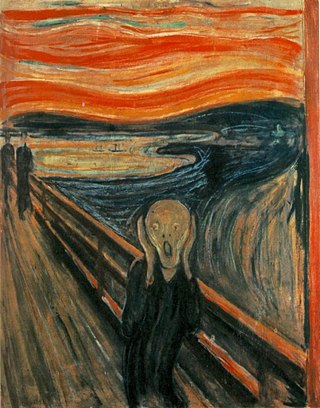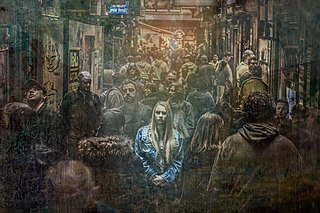Related Research Articles

Anxiety is an emotion which is characterised by an unpleasant state of inner turmoil and includes feelings of dread over anticipated events. Anxiety is different from fear in that fear is defined as the emotional response to a present threat, whereas anxiety is the anticipation of a future one. It is often accompanied by nervous behavior such as pacing back and forth, somatic complaints, and rumination.

Arachnophobia is the fear of spiders and other arachnids such as scorpions and ticks. The word Arachnophobia comes from the Greek words arachne and phobia.

Fear is an intensely unpleasant primal emotion in response to perceiving or recognizing a danger or threat. Fear causes psychological changes that may produce behavioral reactions such as mounting an aggressive response or fleeing the threat. Fear in human beings may occur in response to a certain stimulus occurring in the present, or in anticipation or expectation of a future threat perceived as a risk to oneself. The fear response arises from the perception of danger leading to confrontation with or escape from/avoiding the threat, which in extreme cases of fear can be a freeze response.

A phobia is an anxiety disorder, defined by an irrational, unrealistic, persistent and excessive fear of an object or situation. Phobias typically result in a rapid onset of fear and are usually present for more than six months. Those affected go to great lengths to avoid the situation or object, to a degree greater than the actual danger posed. If the object or situation cannot be avoided, they experience significant distress. Other symptoms can include fainting, which may occur in blood or injury phobia, and panic attacks, often found in agoraphobia and emetophobia. Around 75% of those with phobias have multiple phobias.

Anxiety disorders are a group of mental disorders characterized by significant and uncontrollable feelings of anxiety and fear such that a person's social, occupational, and personal functions are significantly impaired. Anxiety may cause physical and cognitive symptoms, such as restlessness, irritability, easy fatigue, difficulty concentrating, increased heart rate, chest pain, abdominal pain, and a variety of other symptoms that may vary based on the individual.

Agoraphobia is a mental and behavioral disorder, specifically an anxiety disorder characterized by symptoms of anxiety in situations where the person perceives their environment to be unsafe with no easy way to escape. These situations can include public transit, shopping centers, crowds and queues, or simply being outside their home on their own. Being in these situations may result in a panic attack. Those affected will go to great lengths to avoid these situations. In severe cases, people may become completely unable to leave their homes.

Hornets are the largest of the eusocial wasps, and are similar in appearance to yellowjackets, their close relatives. Some species can reach up to 5.5 cm (2.2 in) in length. They are distinguished from other vespine wasps by the relatively large top margin of the head. Worldwide, 22 species of Vespa are recognized. Most species only occur in the tropics of Asia, though the European hornet is widely distributed throughout Europe, Russia, North America, and north-eastern Asia. Wasps native to North America in the genus Dolichovespula are commonly referred to as hornets, but all of them are actually yellowjackets.

Avoidant personality disorder (AvPD) or anxious personality disorder is a Cluster C personality disorder characterized by excessive social anxiety and inhibition, fear of intimacy, severe feelings of inadequacy and inferiority, and an overreliance on avoidance of feared stimuli as a maladaptive coping method. Those affected typically display a pattern of extreme sensitivity to negative evaluation and rejection, a belief that one is socially inept or personally unappealing to others, and avoidance of social interaction despite a strong desire for it. It appears to affect an approximately equal number of men and women.
Aquaphobia is an irrational fear of water.

Fear of needles, known in medical literature as needle phobia, is the extreme fear of medical procedures involving injections or hypodermic needles.

A bee sting is the wound and pain caused by the stinger of a female bee puncturing skin. Bee stings differ from insect bites, with the venom of stinging insects having considerable chemical variation. The reaction of a person to a bee sting may vary according to the bee species. While bee stinger venom is slightly acidic and causes only mild pain in most people, allergic reactions may occur in people with allergies to venom components.
Mysophobia, also known as verminophobia, germophobia, germaphobia, bacillophobia and bacteriophobia, is a pathological fear of contamination and germs. It is classified as a type of specific phobia, meaning it is evaluated and diagnosed based on the experience of high levels of fear and anxiety beyond what is reasonable when exposed to or in anticipation of exposure to stimuli related to the particular concept. William A. Hammond first coined the term in 1879 when describing a case of obsessive–compulsive disorder (OCD) exhibited in repeatedly washing one's hands.

The fear of bees, also known as apiophobia, apiphobia, or melissophobia, is a specific phobia triggered by the presence of bees. It is a variation of entomophobia, a fear of insects. The phobia arises primarily from a fear of bee stings. Fear of bees often coincides with a fear of wasps, another stinging insect, and the two are sometimes conflated by people with bee phobias. A fear of bees can affect quality of life with anxiety around outdoor activities, and people with a bee phobia may experience symptoms of panic upon seeing a bee. Fear of bees may also occur in people who risk life-threatening reactions to stings, but this is considered a rational fear instead of a phobia.
Cynophobia is the fear of dogs and canines in general. Cynophobia is classified as a specific phobia, under the subtype "animal phobias". According to Timothy O. Rentz of the Laboratory for the Study of Anxiety Disorders at the University of Texas, animal phobias are among the most common of the specific phobias and 36% of patients who seek treatment report being afraid of dogs or afraid of cats. Although ophidiophobia or arachnophobia are more common animal phobias, cynophobia is especially debilitating because of the high prevalence of dogs and the general ignorance of dog owners to the phobia. The Diagnostic and Statistical Manual of Mental Disorders (DSM-IV-TR) reports that only 12% to 30% of those with a specific phobia will seek treatment.
Blood phobia is an extreme irrational fear of blood, a type of specific phobia. Severe cases of this fear can cause physical reactions that are uncommon in most other fears, specifically vasovagal syncope (fainting). Similar reactions can also occur with trypanophobia and traumatophobia. For this reason, these phobias are categorized as blood-injection-injury phobia by the DSM-IV. Some early texts refer to this category as "blood-injury-illness phobia."
Ailurophobia is the persistent and excessive fear of cats. Like other specific phobias, the exact cause of ailurophobia is unknown, and potential treatment generally involves therapy. The name comes from the Greek words αἴλουρος, 'cat', and φόβος, 'fear'. Other names for ailurophobia include: felinophobia, elurophobia, gatophobia, and cat phobia. A person with this phobia is known as an ailurophobe.

A wasp is any insect of the narrow-waisted suborder Apocrita of the order Hymenoptera which is neither a bee nor an ant; this excludes the broad-waisted sawflies (Symphyta), which look somewhat like wasps, but are in a separate suborder. The wasps do not constitute a clade, a complete natural group with a single ancestor, as bees and ants are deeply nested within the wasps, having evolved from wasp ancestors. Wasps that are members of the clade Aculeata can sting their prey.

Social anxiety disorder (SAD), also known as social phobia, is an anxiety disorder characterized by sentiments of fear and anxiety in social situations, causing considerable distress and impairing ability to function in at least some aspects of daily life. These fears can be triggered by perceived or actual scrutiny from others. Individuals with social anxiety disorder fear negative evaluations from other people.
Autophobia, also called monophobia, isolophobia, or eremophobia, is the specific phobia or a morbid fear or dread of oneself or of being alone, isolated, abandoned, and ignored. This specific phobia is associated with the idea of being alone, often causing severe anxiety.
References
- ↑ Doctor, Ronald Manual; Kahn, Ada P.; Adamec, Christine A. (2008). The Encyclopedia of Phobias, Fears, and Anxieties (3rd ed.). Facts on File. pp. 457, 506. ISBN 9781438120980 . Retrieved February 25, 2023– via Google Books.
Fear of wasps is known as spheksophobia. Individuals who fear wasps often fear stings, pain, bees, or flying insects in general.
- ↑ Sanders, Diana; Wills, Frank (2003). Counselling for Anxiety Problems (2nd ed.). SAGE Publications. p. 152. ISBN 9781412933360 . Retrieved February 25, 2023– via Google Books.
Table 9.1 / Common phobias / Animals /... Fear of wasps (Spheksophobia)
- ↑ Brough, DI; Yorkston, N; Stafford-Clark, D (1965). "A case of wasp phobia treated by systematic desensitization under light hypnosis". Guy's Hospital Reports . 114 (3): 319–324. PMID 5891230.
- ↑ Brown, June S.L.; Abrahams, Sharon; Helbert, Matthew (September 2003). "An unusual case of a wasp phobic". Journal of Behavior Therapy and Experimental Psychiatry. 34 (3–4): 219–224. doi:10.1016/j.jbtep.2001.09.001. PMID 14972669.